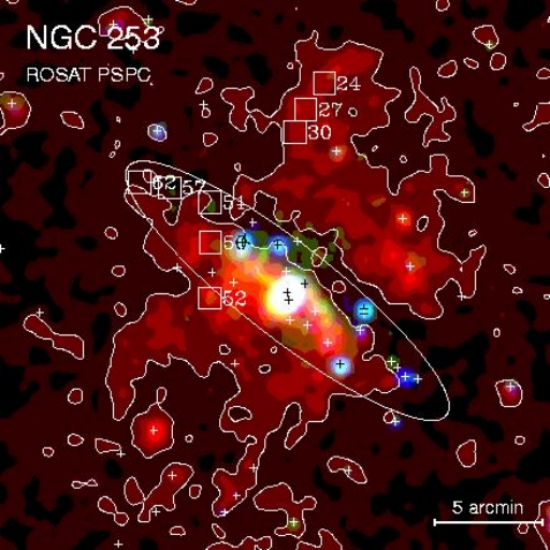
 Credit: The ROSAT Project and the
Max-Planck-Institut für extraterrestrische Physik
Credit: The ROSAT Project and the
Max-Planck-Institut für extraterrestrische Physik
Up the Chimney
Galaxies are dynamic places. Stellar death stirs things up as dying stars
explode as supernovae, carving out huge cavities in the galaxy's gas and
dust. Stellar birth can be traumatic for galaxies too. This is especially
true of the so-called "starburst galaxies", in which extremely massive
stars apparently are forming at an incredibly high rate. The picture above
shows a ROSAT X-ray image of the starburst
galaxy NGC 253. NGC 253 is a spiral galaxy (similar in shape to the
Milky Way) in which the stars and gas in the galaxy are distributed in a
flattened disk. The white ellipse shows the location of the disk of the
galaxy. On either side of the disk are large amounts of hot, X-ray
producing gas. This gas, or X-ray "halo",
is thought to be produced by a strong wind from the nucleus of NGC 253.
Also contributing to this emission is hot gas driven out by the hot regions
of star formation, like hot air flowing up a fireplace chimney. By
analyzing the X-ray emission from the halo, astronomers
have shown that the "bottom" halo is pointing towards us, and the
"upper" halo pointing away from us, unambiguously showing the orientation
of the disk of NGC 253 in space.
Last Week *
HEA Dictionary * Archive
* Search HEAPOW
* Education
Each week the HEASARC
brings you new, exciting and beautiful images from X-ray and Gamma ray
astronomy. Check back each week and be sure to check out the HEAPOW archive!
Page Author: Dr. Michael F.
Corcoran
Last modified December 19, 2001


